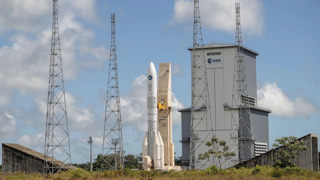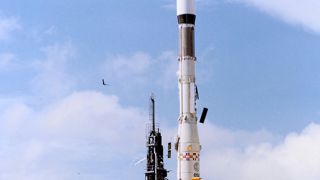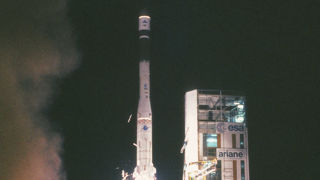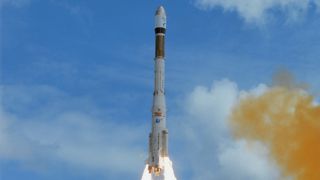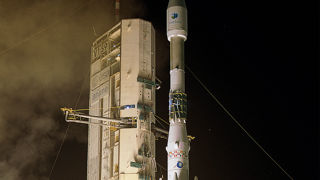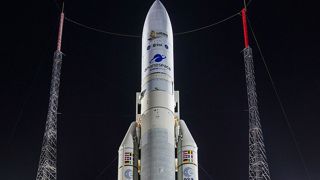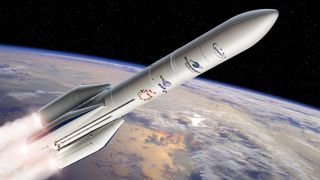
Ariane 6 - Europe's Newest Launch Vehicle
- 10th Jun 2024
- Author: Ed Kellond-Turner
Ariane 6 is Europe's newest launch vehicle, but what is this rocket capable of? And what happened to the other five Ariane rockets?
Let's Talk About the Rocket
The first concept for Ariane 6 was created in December 2014, with the aim of introducing more flexibility to Europe's launch capabilities, as well as halving the costs of launch compared to the Ariane 5. After ten years of development, manufacturing and testing, Ariane 6 launched on 9 July 2024 carrying various payloads, though it was primarily a demonstration flight. Whilst there was an anomoly that prevented the final batch of payloads being released, the inaugural flight was deemed successful, and so it's likely we'll see a second flight before the end of the year with the hope that it will be able to launch up to ten times a year when fully operational.
Ariane 6 is a two stage expendable rocket fuelled by liquid hydrogen, with an improved version of the Ariane 5's Vulcain engine on the first stage and the newly developed Vinci engine on the second stage. The Vinci engine gives Ariane 6 an edge over other launch vehicles such as the Falcon 9 due to its ability to restart multiple times, getting satellites close to their operational orbits much faster.
There are two variants of the Ariane 6 planned: Ariane 62 and Ariane 64, related to the number of P120 solid rocket boosters the rocket has to help carry heavy satellites into orbit. To help reduce costs, the P120 motor is also the first stage of Europe's other launch vehicle, the Vega C.
Ariane 6 already has several planned missions on the books, including Galileo satellite launches, as well as PLATO, Athena and LISA. Ariane 6 also has the capability of rideshare missions for multiple small satellites at the same time.
The Ariane Family Fact File
Let's compare the six Ariane rockets that have been produced so far. Some of these rockets had variants, such as different amounts of boosters used, so these statistics include the maximum capability of launch mass to orbit.
LEO - Low Earth Orbit. An orbit centred around the Earth up to an altitude of 2000 kilometres.
GTO - Geostationary / Geosynchronous Transfer Orbit (GTO). This is an orbit centre around the Earth and many satellites are put into GTO as an intermediate step before being places into their final geostationary or geosynchronous orbit.
-
![The First Launch of Ariane 1]()
ESA Ariane 1
Height: 50 metres
Diameter: 3.8 metres
Years Active: 1979 - 1986
Total Launches: 11
Successes: 9
Mass to LEO: 4850 kg
Mass to GTO: 1850 kg
-
![The Launch of Ariane 2 V20]()
ESA Ariane 2
Height: 49.13 metres
Diameter: 3.8 metres
Years Active: 1986 - 1989
Total Launches: 6
Successes: 5
Mass to LEO: Undefined
Mass to GTO: 2175 kg
-
![The First Launch of the Ariane 3]()
ESA Ariane 3
Height: 49.13 metres
Diameter: 3.8 metres
Years Active: 1984 - 1989
Total Launches: 11
Successes: 10
Mass to LEO: Undefined
Mass to GTO: 2700 kg
-
![View of the Last Ariane 4 Launch]()
ESA Ariane 4
Height: 58.72 metres
Diameter: 3.8 metres
Years Active: 1988 - 2003
Total Launches: 116
Successes: 113
Mass to LEO: 5000 - 7600 kg
Mass to GTO: 2000 - 4300 kg
-
![Ariane 5 With James Webb Space Telescope Prelaunch]()
ESA Ariane 5
Height: 46 - 52 metres
Diameter: 5.4 metres
Years Active: 1996 - 2023
Total Launches: 117
Successes: 112
Mass to LEO: 20,000 kg
Mass to GTO: 10,865 kg
-
![Artist's View Of The Configuration Of Ariane 6 Using Four Boosters A64 Pillars]()
ESA Ariane 6
Height: 63 metres
Diameter: 5.4 metres
Years Active: 2024 -
Mass to LEO: 21,650 kg
Mass to GTO: 11,500 kg
If previous Ariane rockets are anything to go by, Ariane 6 is likely to be a highly successful rocket with a very low number of launch failures.
What's NEXT?
Ariane Group is one of the main partners for the SALTO Project, which 'aims to raise the maturity level of the first European reusable rocket technology'. In other words, Europe doesn't want to be underpriced in the launch market by reusable rockets like the Falcon 9, leading to the design and development of Ariane NEXT. Aiming to fly in the 2030s, Ariane NEXT will halve the cost of an Ariane 6 launch, without losing any of its capabilities.
Full image credits / references
(Banner image) Artist's View Of The Configuration Of Ariane 6 Using Four Boosters A64 Pillars. Credit: ESA
(1) Test removal of Ariane 6 from the mobile gantry at Europe's SpacePort in Kourou, French Guiana on June 23, 2023. Credit: ESA
(2a) The First Launch of Ariane 1. Credit: ESA
(2b) The Launch of Ariane 2 V20. Credit: ESA
(2c) The First Launch of the Ariane 3. Credit: ESA
(2d) View of the Last Ariane 4 Launch. Credit: ESA
(2e) Ariane 5 With James Webb Space Telescope Prelaunch. Credit: ESA
(2f) Artist's View Of The Configuration Of Ariane 6 Using Four Boosters A64 Pillars. Credit: ESA
(3) Ariane 6 Launch Animation: Credit: ESA

